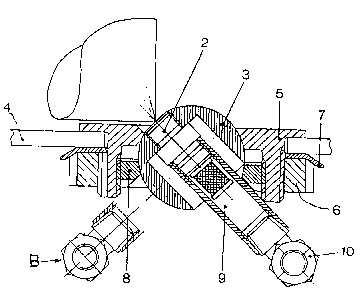Some of the information on this Web page has been provided by external sources. The Government of Canada is not responsible for the accuracy, reliability or currency of the information supplied by external sources. Users wishing to rely upon this information should consult directly with the source of the information. Content provided by external sources is not subject to official languages, privacy and accessibility requirements.
Any discrepancies in the text and image of the Claims and Abstract are due to differing posting times. Text of the Claims and Abstract are posted:
| (12) Patent: | (11) CA 2050487 |
|---|---|
| (54) English Title: | INJECTION DEVICE FOR THE ON-LINE WET CLEANING OF COMPRESSORS |
| (54) French Title: | DISPOSITIF D'INJECTION POUR LE LAVAGE DE COMPRESSEURS EN MARCHE |
| Status: | Term Expired - Post Grant Beyond Limit |
| (51) International Patent Classification (IPC): |
|
|---|---|
| (72) Inventors : |
|
| (73) Owners : |
|
| (71) Applicants : |
|
| (74) Agent: | NORTON ROSE FULBRIGHT CANADA LLP/S.E.N.C.R.L., S.R.L. |
| (74) Associate agent: | |
| (45) Issued: | 2001-10-02 |
| (86) PCT Filing Date: | 1991-02-08 |
| (87) Open to Public Inspection: | 1991-08-22 |
| Examination requested: | 1997-11-26 |
| Availability of licence: | N/A |
| Dedicated to the Public: | N/A |
| (25) Language of filing: | English |
| Patent Cooperation Treaty (PCT): | Yes |
|---|---|
| (86) PCT Filing Number: | PCT/CH1991/000035 |
| (87) International Publication Number: | WO 1991012433 |
| (85) National Entry: | 1991-10-11 |
| (30) Application Priority Data: | ||||||
|---|---|---|---|---|---|---|
|
In an injection device for the ON-LINE wet
cleaning of compressors, the liquid cleaning agent is
injected via a nozzle into the flow passage upstream of
the compressor. The nozzle is a molecular atomizer which
is mounted in the casing wall of the compressor in such
a way that it can be adjusted in a three-dimensional
manner in a ball-and-socket joint and can be maintained,
adjusted or even exchanged during the operation of the
machine.
Note: Claims are shown in the official language in which they were submitted.
Note: Descriptions are shown in the official language in which they were submitted.

2024-08-01:As part of the Next Generation Patents (NGP) transition, the Canadian Patents Database (CPD) now contains a more detailed Event History, which replicates the Event Log of our new back-office solution.
Please note that "Inactive:" events refers to events no longer in use in our new back-office solution.
For a clearer understanding of the status of the application/patent presented on this page, the site Disclaimer , as well as the definitions for Patent , Event History , Maintenance Fee and Payment History should be consulted.
| Description | Date |
|---|---|
| Inactive: Expired (new Act pat) | 2011-02-08 |
| Grant by Issuance | 2001-10-02 |
| Inactive: Cover page published | 2001-10-01 |
| Inactive: Final fee received | 2001-06-13 |
| Pre-grant | 2001-06-13 |
| Notice of Allowance is Issued | 2000-12-19 |
| Letter Sent | 2000-12-19 |
| Notice of Allowance is Issued | 2000-12-19 |
| Inactive: Approved for allowance (AFA) | 2000-12-01 |
| Amendment Received - Voluntary Amendment | 2000-10-31 |
| Inactive: S.30(2) Rules - Examiner requisition | 2000-05-03 |
| Inactive: Application prosecuted on TS as of Log entry date | 1997-12-19 |
| Inactive: RFE acknowledged - Prior art enquiry | 1997-12-19 |
| Inactive: Status info is complete as of Log entry date | 1997-12-19 |
| All Requirements for Examination Determined Compliant | 1997-11-26 |
| Request for Examination Requirements Determined Compliant | 1997-11-26 |
| Application Published (Open to Public Inspection) | 1991-08-22 |
There is no abandonment history.
The last payment was received on 2001-01-25
Note : If the full payment has not been received on or before the date indicated, a further fee may be required which may be one of the following
Please refer to the CIPO Patent Fees web page to see all current fee amounts.
| Fee Type | Anniversary Year | Due Date | Paid Date |
|---|---|---|---|
| Request for examination - standard | 1997-11-26 | ||
| MF (application, 7th anniv.) - standard | 07 | 1998-02-09 | 1998-01-28 |
| MF (application, 8th anniv.) - standard | 08 | 1999-02-08 | 1999-01-20 |
| MF (application, 9th anniv.) - standard | 09 | 2000-02-08 | 2000-01-14 |
| MF (application, 10th anniv.) - standard | 10 | 2001-02-08 | 2001-01-25 |
| Final fee - standard | 2001-06-13 | ||
| MF (patent, 11th anniv.) - standard | 2002-02-08 | 2002-01-18 | |
| MF (patent, 12th anniv.) - standard | 2003-02-10 | 2003-01-21 | |
| MF (patent, 13th anniv.) - standard | 2004-02-09 | 2004-01-19 | |
| MF (patent, 14th anniv.) - standard | 2005-02-08 | 2005-01-18 | |
| MF (patent, 15th anniv.) - standard | 2006-02-08 | 2006-01-24 | |
| MF (patent, 16th anniv.) - standard | 2007-02-08 | 2007-01-23 | |
| MF (patent, 17th anniv.) - standard | 2008-02-08 | 2008-01-23 | |
| MF (patent, 18th anniv.) - standard | 2009-02-09 | 2009-01-26 | |
| MF (patent, 19th anniv.) - standard | 2010-02-08 | 2010-01-07 |
Note: Records showing the ownership history in alphabetical order.
| Current Owners on Record |
|---|
| TURBOTECT AG |
| Past Owners on Record |
|---|
| RUDOLF ROBBEN |
| SEJKO KOLEV |